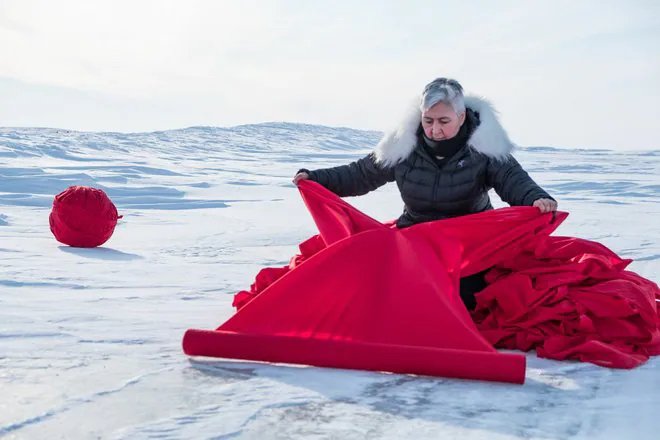Stories Through Art
Maureen Gruben’s art piece, “Seal in Our Blood”
When it’s shown in gallery spaces, Inuvialuk artist Maureen Gruben’s textile installation titled “Seal in Our Blood” is usually hung in a long strand from the ceiling.
The 30-foot rope sewn from sealskin scraps and red velvet material tells a story of nourishment and survival for Inuit across the Arctic, says Gruben.
“When I made it I was thinking how seals have been an important food source for Inuit people,” she says. “Without the seal we would not have survived. They provide clothing, warmth, food. We’re just as dependent on the seal as the polar bears are, the Inuit people.”
Gruben works with raw materials like sealskin, beluga intestine and polar bear fur, deconstructing the natural mediums and incorporating industrial material like plastics, resin and metal.
Visual art styles in the western community of Tuktoyaktuk are diverse, but each piece tells stories of life in the North.
Taalrumiq sewing a sealskin earring
Artist Taalrumiq says the community is seeing a “resurgence” in works that combine ancestral skills with modern art.
“I still see that ingenious Inuit creativity in everything, not just what I’m doing but in the whole community,” she says. “We’ve always been ‘just try something’ and you pick it up so quickly. That’s all of our people, we’re so creative.”
Plans to construct a cultural centre for art and tourism in Tuktoyaktuk would share this resurgence with the world. For the community the Saliqmiut: Tuktuuyaqtuuq Centre for Arts and Culture would be a space to sew, bead, paint, carve, create and connect people now to their stories from the past.
“There’s a lot of things tied to storytelling from our elders before me,” says elder Peter Nogasak. “That comes through what people have done out on the land, what they have seen, what their ancestors have done before.”
Storytelling as its own medium is an integral part of Inuit culture, where art and oratory are how histories are preserved.
For Gruben, the impact of climate change is one story she can’t help but tell through her work, because it’s such an everyday reality for Inuvialuit she says. At the National Gallery you can find her piece, “Message,” where red stitching spells SOS in morse code over top 17-feet of polar bear guard hair.
“Message” by Maureen Gruben
“I’m really glad that a lot of people see it because it brings that awareness of our environment here in the Western Arctic to the world,” she says.
After watching her brother stretch out a seal intestine she had the idea to create her piece titled “Stitching my Landscape.” Gruben threaded read broadcloth through 111 ice fishing holes drilled by her nephews. It spanned over 1,000 feet of sea ice.
The stitches brought up memories, and helped her heal.
“There’s been so many injustices done to Inuvialuit and to Indigenous people in the world,” she says.
Building a community space like Saliqmiut to celebrate heritage, art and language will in turn create space for healing.
“Art and storytelling go hand in hand,” says Gruben. “That always makes our spirits stronger when we hear our own stories.”




